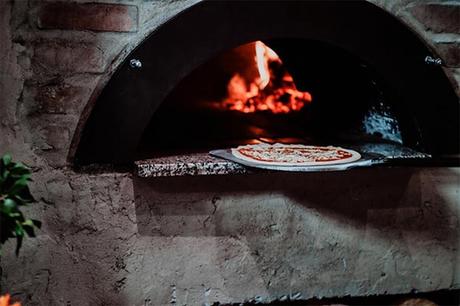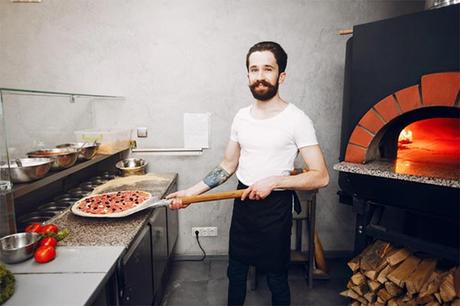Outdoor pizza oven — For domestic and commercial use
Outdoor pizza ovens are a great addition to any backyard, especially if you’re a fan of home-made food. They’re a versatile complement to grills and smokehouses, allowing you to prepare a variety of dishes — despite pizza in their name, they can be used to make all kinds of baked and roasted meals. What exactly can you make and how does a pizza oven work? You can find the answers for these, and a few more, questions below.
What’s a pizza oven?
To put it simple, it’s a type of (mostly) wood-fired, flat floored oven with a (in most cases circular) domed vault. The dome can be made from thick layers of clay, ceramics or bricks — this way the heat retention is maximized, creating a very high-temperature cooking environment. The overall pizza oven’s appearance may differ, depending on region or simply users’ preferences. Take the chimney for example — in southern regions it’s almost always positioned in the front (right above the oven’s mouth), whilst in the north it’s commonly set up in the back. In some cases, wood-fired pizza ovens don’t even have a chimney. Why? Because this solution allows them to keep high temperature inside for longer and minimizes heat loss. It’s a solid option for an outdoor pizza oven, but you shouldn’t put one of those indoors — the lack of a proper chimney means that all the smoke produced during heating escapes right through the oven’s mouth, even when the door is closed. This might not only stain your walls, but also be a health (or even life) hazard.
Pizza ovens should be heavily insulated, so that all the heat is kept inside while the exterior remains cool and can be touched safely.

Where to place outdoor pizza ovens?
There are two rules regarding the localization of an outdoor pizza oven:
- It can’t be placed near storage of any kind of fuel,
- It should be sheltered from strong winds.
Other than that, there’s really a lot of freedom in the matter. Pizza ovens can be set up in gardens, backyards, on terraces or patios. They can also be integrated into already existing structures like brick grills. There are even portable ovens, which can be moved around and placed almost anywhere, thanks to their compact size.
How to operate an outdoor pizza oven?
Despite small differences in build, all the wood-fired pizza ovens are generally used in the same, quite easy way. The first step is to make a fire in the back part of the oven, so it can heat up. The shape and material of the dome (and base too) allows it to store heat, which is later used to cook food. When it reaches desired temperature, you’ll need to remove all the ashes and embers. After that, put your dough (or any other meal) on a cleaned patch in the center of the floor. All it’s left for “the magic” to happen is to close the door — the accumulated heat will slowly radiate and cook your food. It’s important to position the food in the centre, as the shape of the vault makes all the heat concentrate in the middle of the cooking surface. This will let you to cook it evenly from all sides without the need to rotate it.
The aforementioned method is great, but it has one drawback — cooking this way takes time. This doesn’t mean that you can’t use your pizza oven for a quick bite. Especially that pizza is meant to be a quick to prepare meal. So what should you do to get it ready much faster? It’s simple — instead of removing all the embers/burning wood and ashes simply push them all the way to the back wall and don’t close the door after putting in your pizzas. Your meal will be ready in just a few minutes, but you’ll have to remember to rotate it periodically, so it can be cooked evenly from all sides. A thin, crispy pizza can be ready in just 90 seconds, if the temperature is right (about 430℃).
What meals can be prepared in outdoor pizza ovens?
As we mentioned before, pizza ovens aren’t just for pizza. They can be used for preparing anything that can be grilled, roasted or baked. The most obvious options are: barbecued meat (all kinds, e.g. pork or poultry), skewers, roasted fish, grilled seafood, steaks, bread and pies. What else? All sorts of desserts — e.g. tarts, brownies, cinnamon rolls, or even meringues and s’mores. Pizza ovens can also be used for all kinds of stews, gratins, grilled cheese and even humble toasts. In general, you can say there’s a rule of thumb — if you can name a meal, you can probably cook it in a pizza oven.
After the main cooking is done, you can also use the leftover heat for other purposes, as it’s emitted for a long time. What can you do with it? Anything that requires higher temperature — from drying mushrooms, fruits and vegetables, to keeping your drink nice and warm.
How hot can a pizza oven get?
The exact peak depends on the materials used, but in general pizza ovens can get quite hot — 500℃ and up. Modern wood-fired pizza oven can even withstand temperatures up to 1000℃. Of course, you won’t have to get them this hot to prepare your meals — here’s a short overview of temperatures, styles of cooking and examples of dishes:
- 400℃+ — pizza cooking (e.g. pizza, naan bread or garlic bread),
- 280-320℃ — grilling (e.g. shrimp, steak, sardines),
- 230-280℃ — roasting (e.g. whole fish, potatoes, whole turkey/chicken),
- 200-230℃ — bread baking (e.g. foccacia, sourdough, bread, pizza rolls),
- 160-200℃ — baking desserts (e.g. cinnamon rolls, carrot cake, apple pie),
- 100-120℃ — slow cooking (e.g. stews, barbecued ribs, pulled pork).

What kind of fuel should be used?
Most of the pizza ovens are wood-fired, but some of them also have backup gas-fueling or run solely on it.
While using a wood-fired one, you need to remember that the tape of wood used will greatly affect the taste of cooked meals. If possible, avoid the wood coming from conifer trees (softwood), as it burns too fast and also contains a lot of essential oils and resin which can greatly alter the food’s taste and produce a lot of soot when burned. It’s recommended to use wood from cherry, beech or gean (Prunus avium) — they’re the safest bet. If you can’t get that, charcoal made from birch, hornbeam or ash is a solid alternative. Your last choice, although not really recommended, should be wood briquette, but you’ll have to make sure that it doesn’t have even the slightest additions of softwood.
As for the gas — simply use high-quality one from a well-trusted provider.
Who are the pizza ovens for?
Outdoor pizza ovens can be used both for domestic and commercial purposes. Depending on their size, they can be used for making from 1 to 6+ pizzas at one time. This makes them ideal for day-to-day cooking, small parties with friends and family, professional pizza restaurants and even big festivals — everyone can find a size meeting their requirements if they look hard enough. Of course, the bigger the oven, the higher the price.
How much does a pizza oven cost?
The pricing of ovens varies greatly, depending on materials used, quality, size and features. In general though, a small oven for one pizza is priced at about £700 (plus installation costs). The biggest ones, used almost solely for commercial purposes, have a price tag of £3000+. Of course, you can grab one with discounts like free shipping or a seasonal sale which can lower the price significantly.
But the initial cost isn’t everything — you’ll also have to consider the running costs. Fortunately, they are quite modest — despite the size, even the largest ovens require rather small amounts of fuel to operate properly. In most cases a small, domestic one would need roughly 4 kg of dry hardwood per hour, just about the same as any wood fire burning — it corresponds to two large pieces of wood. It’s also worth noting, that the maintenance costs are rather low too — pizza ovens don’t have any moving or electrical parts to replace and maintain. In other words, a well-built oven can last whole decades, even if used on regular basis.
Buy one or build one?
This depends on a few factors, but the price isn’t one — both buying and building will cost you roughly the same. So what does it depend on? The three main factors are: time, purpose and predispositions.
- Time — buying and assembling one (even with shipping) is quite straightforward and doesn’t take long (maybe two weeks), whilst building a clay and brick pizza oven takes from about a week to one month+, as you’ll have to wait for individual layers to dry properly. This depends highly on the weather and will take longer, the wetter it will be. So if you need your pizza oven as soon as possible, it’s better to buy one. But if time isn’t of the essence, building one is an equally viable option.
- Purpose — if you plan on using your pizza oven solely for domestic purposes or for a small cooking business, you can just build it yourself (provided you have the necessary skills and use quality materials). But if your goal is to provide high-profile commercial cooking services, buying one would be a safer bet, as it guarantees high quality and is far harder to mess up during assembling. It’ll also give you a warranty, which cannot be said about a DIY one.
- Predispositions — building brick pizza ovens requires some skill and a knack for DIY projects, so that the final product can function properly. Pizza ovens are most often sold in easy to assemble parts and can be set up rather quickly and correctly by essentially anyone — if you’re a complete no-talent builder, you can even pay for its installation. In other words, buying one is way easier and doesn’t require any additional skill, so it’s way more convenient. On the other hand, building your own pizza oven can bring you a solid dose of satisfaction and self-fulfillment (not to mention the bragging rights) which can carry you through dull reality of a day by day life. If you’re planning on building your very own pizza oven, all the necessary materials can be found here.
In the end, both options have their pros and cons and the final decision depends solely on individual preferences.
Benefits of owning a pizza oven
If cooking delicious home-made food in your own outdoor kitchen for relatively low cost isn’t enough reason for you to consider owning one of those, pizza ovens can also bring you:
- personal satisfaction (both from cooking and building one by yourself),
- the ability to cook both slow and fast food in one go (heat needed for e.q. quick pizza can be later used for cooking other meals),
- great aroma of wood (which can really enrich any meal),
- entertainment (special window for display cooking can be installed in many pizza ovens).
Pizza ovens can also be decorated in many ways, so you can even let loose your inner artist with them.
Summary
Outdoor pizza ovens are a great way for preparing healthy, home-made food. They are rather easy to operate and can be used both domestically and commercially with great success. Despite being named after pizza, they’re very versatile tools for preparing wide variety of meals. If you use them properly, they can last very long without any maintenance needed. Pizza ovens can be bought or built — both options are roughly equally cost-efficient. Therefore, the choice is mostly a matter of personal preferences.
